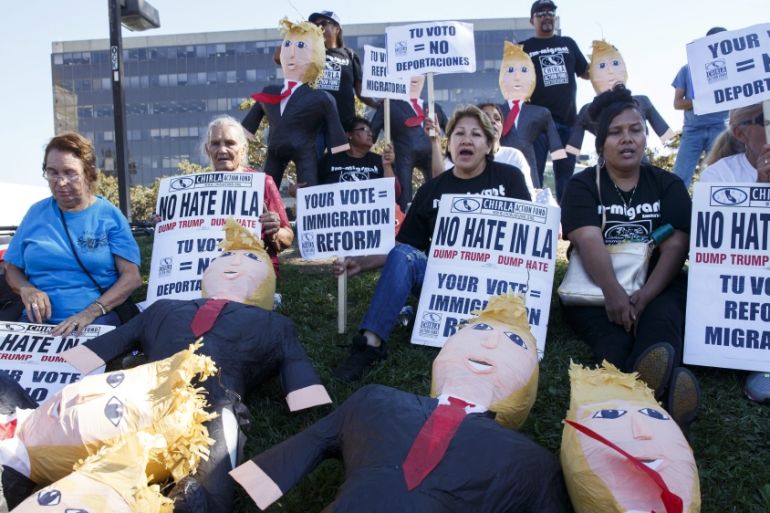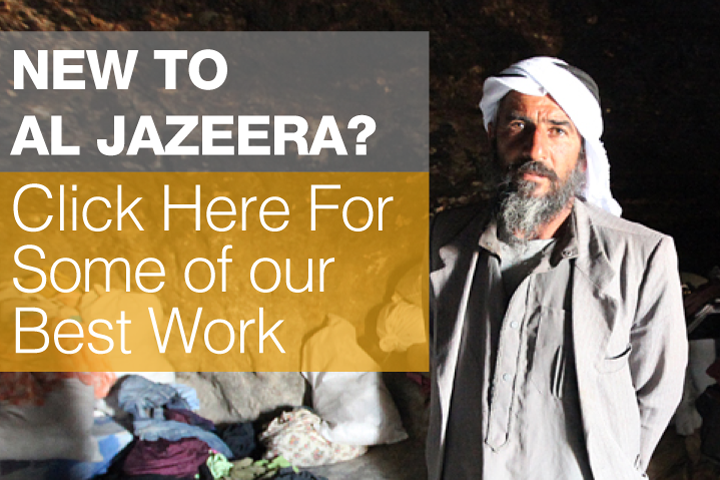What’s the future of US for-profit immigrant detention?
Private prison stocks sky-rocketed following the victory of Donald Trump, who has promised mass deportations.

Austin, Texas, United States – When Sulma Franco fled her native Guatemala in 2009, she planned to reach the United States and apply for asylum on humanitarian grounds.
|
|
But things did not turn out as Franco, a 32-year-old member of the LGBT community, had imagined.
Keep reading
list of 4 itemsPalestinian Prisoner’s Day: How many are still in Israeli detention?
‘Mama we’re dying’: Only able to hear her kids in Gaza in their final days
Europe pledges to boost aid to Sudan on unwelcome war anniversary
“I left Guatemala for many different reasons,” she said, explaining that she was a victim of violence because of her LGBT rights activism. Due to legal reasons, she cannot elaborate on the events that led to her departure.
The journey was long and brutal.
“I had to cross through Mexico, and there are many dangers through that route, like being kidnapped, raped or assaulted.”
Like the millions of people who have fled Central America for the US in the past, Franco felt afraid when her life was in the hands of human traffickers.
“I’ve also seen women being sexually assaulted; kidnapped,” she recalled. “You want to believe that there are good people who will help you, but in reality, there are people on this journey to the US that are also part of trafficking networks.”
Eventually making it to the US, Franco was arrested by immigration authorities within a few hours of crossing the border from Mexico into Texas. She was promptly placed in a for-profit immigrant detention centre, a facility where, she says, abuse and mistreatment are rampant.
A large portion of the more than 180 immigrant detention centres in the US are operated by private contractors.
READ MORE: US urged to free immigrant female hunger strikers
The Department of Homeland Security cast doubt on the future of the private detention facilities in August, when the agency’s security secretary said President Barack Obama’s administration may stop using the facilities to effectively incarcerate immigrants.
While Obama deported a record 2.5 million immigrants between 2009 and 2015, Donald Trump has vowed to deport up to three million.
The president-elect has been widely criticised for his anti-immigrant positions and has vowed to bulk up border, immigration and police authorities – possibly preventing for-profit detention centres from closing.
Abuses
After being arrested by immigration authorities, Franco was first put in T Don Hutto, a notorious for-profit detention centre in Taylor, Texas.
As part of an agreement with US Immigrations and Customs Enforcement (ICE), the detention centre is operated by Corrections Corporation of America (CCA). The federal government pays CCA $150 a day for each detainee, according to the Austin-based Grassroots Leadership NGO, which campaigns against for-profit detention.
![Sulma Franco fled her native Guatemala after being the target of violence for her activism [Patrick Strickland/Al Jazeera]](/wp-content/uploads/2016/11/2fe5526c508b42bfbf0b3207369eba7d_18.jpeg)
Franco said the detainees were treated harshly by the guards and administration, accusing them of blocking their access to communication, providing them with poor food and limiting their access to adequate medical care.
“They deprive you of your freedom; you can’t really have much contact with other people. The food is terrible. And there is abuse of power by so-called ‘caretakers’, who should really be called ‘janitors’ because they lack proper training,” she said.
READ MORE: Is this the end of prison for profit in the US?
“They were always threatening us that they were going to kill us, that they were going to put us in isolation … if we committed any infractions. Or if we did something they simply didn’t like.”
Franco was released from T Don Hutto under a supervision order after four months. As part of the conditions, she was required to meet an immigration officer every four-to-six months while her asylum case was being processed.
For a few years, life was good for Franco, and she was even able to get a permit and open a business – a food truck – in Austin, Texas, where she started to build a new life.
Then, one day in 2014, immigration authorities detained her again when she showed up to an appointment with her case officer. “They told me they were going to arrest me and deport me because my lawyer lost some documents,” she recalled.
Before she knew it, she was in another for-profit detention centre, this time in Laredo, Texas. She was there for two months before being transferred to another facility in Arizona.
With the help of activist groups and rights organisations, her deportation was stalled and she was eventually released.
“If anyone spoke out and said, ‘You can’t treat us like this,’ the [guards] always punished us,” she recalled. “So, we always had to live by the rules of the guards.”
Last year, T Don Hutto and several other for-profit detention centres were rocked by mass hunger strikes in protest against the poor conditions.
‘Shadow prisons’
The abuses that Franco describes are not rare. A new report by the Southern Poverty Law Centre (SPLC) – Shadow Prisons: Immigrant Detention in the South (PDF) – concludes that government-run and private immigrant detention centres are “already rife with civil rights violations and poor conditions”.
In the LaSalle detention centre in Louisiana, the SPLC report documented the deaths of three immigrants in the first six months of 2016.
“Other detainees worry the deaths could have been prevented if the detention centre had provided better medical care, and fear what will happen to them if they get sick,” the report notes.
READ MORE: US guards ‘taunt hunger-striking asylum seekers’
Based on 300 interviews, the report goes on to describe detained immigrants being beaten, threatened with pepper spray and stun guns and placed in solitary confinement when they complained about the difficult living conditions.
Speaking to Al Jazeera, the SPLC’s deputy legal director Lisa Graybill said the government should “come to its senses and stop detaining so many people”.
“But, in fact, things look like they’re moving in the opposite direction,” she lamented.
“We’re particularly concerned about [the] privatisation of county facilities, about federal government contracting out [detention],” Graybill said, adding that these concerns are “compounded by what Trump has said he and his administration would do.”
ICE did not reply to Al Jazeera’s email requests for a comment.
Stocks soaring
Although the exact number of immigrants in for-profit detention varies from day-to-day, a 2009 congressional mandate requires ICE to keep at least 34,000 beds maintained a day.
Despite speculation that the US government may phase out its use of the facilities, private prison stocks soared following the election of President-elect Donald Trump on November 8, according to the financial news site Bloomberg.
“What we are going to do is get the people that are criminal and have criminal records, gang members, drug dealers,” Trump told the 60 Minutes television programme, following his electoral victory.
Bethany Carson, an immigration researcher at Grassroots Leadership, referred to the need for immigrant detention as “a manufactured one” in a recent statement.

“[Department of Homeland Security] has created these astronomical detention numbers by rejecting common-sense reforms that would allow immigrants to live with their families and communities while their legal cases are in process,” Carson said.
Back in Austin, Sulma Franco recalled receiving yet another deportation order, just two months after she moved back to the city.
In June 2015, on the day she was supposed to surrender herself for deportation, Franco was given refuge at the First Unitarian Universalist Church in Austin, Texas.
With community activists rallying around her for two-and-a-half months, she was eventually awarded a stay of deportation. But she still fears a deportation order may arrive again, one day.
“It was particularly difficult because I spent months of my life in sanctuary and [more than a year] in detention, deprived of liberty,” she concluded. “It was humiliating and frustrating not to be able to live like other people live.”
Follow Patrick Strickland on Twitter: @P_Strickland_
Follow Shaghayegh Tajvidi on Twitter: @S_Tajvidi